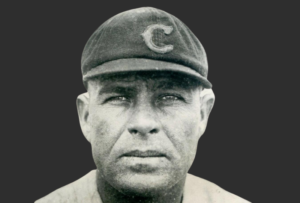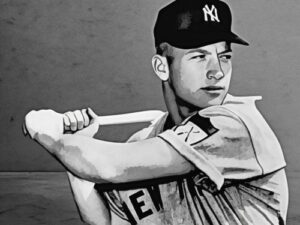I was only a few days into my tenure working at the Baseball Hall of Fame when I found myself sitting in a meeting in which staff members were going over some topics of discussion. One of them was a recent 50th anniversary celebration of the famous Eddie Gaedel appearance as a pinch-hitter in 1951. There was concern among some of the staff.
The Hall of Fame had received a stern letter from the American Association of Little People, who were irritated that an event that exploited Gaedel, who was a 3’7 little person, was given such attention.
“I don’t give a damn what the little people think,” barked on old timer on the staff, only a few weeks away from retirement. “It’s baseball history.”
Clearly, the American Association of Little People didn’t agree.
What is the legacy of the Gaedel appearance? Could it happen today? What can we learn from a stunt that largely defined the creative and controversial career of one of the game’s most flamboyant owners?
Eddie Gaedel Pinch Hits for the Browns, August 19, 1951
The doubleheader played on Sunday, August 19 in St. Louis between the Browns and Tigers was a spectacle, even before a little person went to the plate.
Browns’ owner Bill Veeck chose that day to unveil a bevy of activities between games, ostensibly to celebrate the 50th anniversary of the birth of the American League. Veeck always had a list of ideas for ballpark promotions. While his Browns may have bene a terrible team (and they were), Veeck didn’t feel his fans had to go unentertained. No stunt was too bizarre. Once, earlier when he operated the Indians, Veeck held a night for an ordinary fan, plying the unsuspecting man with a new car, an icebox, a donkey, and other gifts.
The spectacle between games of the doubleheader was extraordinary, as reported by The Sporting News:
Bill Veeck, whose spectacular extra-curricular shows at the Milwaukee and Cleveland parks earned him an international reputation, pulled out all the stops at Sportsman’s Park during the double-header with the Tigers, August 19. The president of the Browns capped all of his previous stunts with the insertion of a midget into the Browns’ lineup, introduced a clown, a short-skirted miss and jugglers, put on an ancient automobile show and presented many other added attractions.
The Sporting News, August 29, 1951
Amazingly, Gaedel was at the center of the celebration, popping out of a giant birthday cake that was rolled onto the field by a group of clowns. Gaedel was wearing a full Browns’ uniform as he emerged from the cake, waving his cap to the large crowd. Only three men knew that Gaedel was wearing the uniform because he was in fact, at that time, an official member of the team.
Prior to the second game, Veeck had informed the official scorer and the opposing team of a roster change, listing “E. Gaedel” on a scorecard that named the St. Louis roster. Only one astute newspaper writer noticed, cornering Veeck in the dugout to ask him about it. The St. Louis owner waved the sportswriter away and mumbled something about it being none of his business.
A regular lineup took the field for the home Browns in the top of the first. A crowd of just over 18,000 was in attendance. The right fielder was a man named Frank Saucier, who was also listed as the leadoff man for the Browns. But in the bottom of the first, manager Zack Taylor, a crusty former catcher, told Saucier to sit down. “Your day is done, Frank,” Taylor said.
Throughout the first inning, Gaedel had been sitting near the end of the bench, but none of his teammates talked to him. They just figured he was another one of Veeck’s cronies, and paid no mind to the “midget” in cleats. But when Taylor pointed his finger at Gaedel, the little man was suddenly the focus of everyone in the dugout.
The 3-foot-7-inch-tall Gaedel grabbed three bats and stepped onto the field in front of the home dugout. He was wearing a standard wool uniform that bloused and looked too big for him, even though Veeck had it tailored to fit a man of his stature. On the right sleeve of the jersey was a 50th anniversary American League patch, and on the front was the raised, stitched letters spelling out “ST LOUIS”. On the rear of the jersey was the number “1/8”.

Detroit manager Red Rolfe didn’t know what was happening initially. He thought Gaedel was performing a trick or that the little man was going to coach first base as part of a stunt. But one of his coaches told him that it appeared that Gaedel was going to the plate to hit. Before Rolfe could object, the three-man umpiring crew was closing in on Eddie Gaedel.
“I didn’t know what they [they] were up to,” said crew chief Art Passarella, who was working first base for the game. “I talked with [home plate umpire Ed] Hurley, and [umpire Joe] Paparella, and we didn’t know what to do about it.”
Taylor joined Gaedel in the on-deck circle where the midget was waving three tiny toy bats in his hands. Hurley was looking down at Gaedel and asking him what the hell he thought he was doing. Taylor produced a contract from his back pocket: a legal, official American League standard player contract with Gaedel’s name and signature and the approval from the league office. Once Hurley read it, he shrugged and ordered Gaedel to get into the box. Hurley made a slight glance up to the press box where he made a facial expression that might have implied “this is crazy.”
Later, some fans in attendance reported that there was laughter among many in the crowd. Jim Delsing, a young outfielder on the Browns, later admitted that most of the players in the home dugout were doubled over in laughter.
The catcher was Bob Swift, and the Detroit pitcher was a man named Bob Cain, who was 30 inches taller than Gaedel. Cain couldn’t believe his eyes, and after a quick glance at his manager he stepped onto the rubber and tried to find a way to toss a strike to a man whose strike zone was about 12 inches high. Cain missed with two soft tosses to make it 2-and-0. That’s when he waved Swift to the mound for a conference.
“He told me he thought he better throw it hard,” Swift later remembered. “So we decided to just use the fastball and have [Cain] throw it as hard as he could, hoping it found the plate.”
Little Eddie Gaedel stood frozen in the batters’ box, a plastic bat resting on his rear, right shoulder. When he hired Gaedel for the gig, Veeck had sensed that the cock Gaedel might actually try to swing at a pitch. He told Gaedel that “if you take the bat off your shoulder, a sniper will shoot you dead.” It was a bluff, but it worked.
Gaedel watched ball three and ball four, and trotted to first with a walk. The crowd erupted in cheers, and at this moment, Eddie doffed his brown wool cap and waved it above his head. He was the star of the show. Taylor sent in a pinch-runner, and Eddie continued to acknowledge cheers as he traveled back to the dugout. A few teammates nudged their little compatriot to go back out to the field and wave his cap one last time, which Gaedel did. The Sportsman’s Park crowd delighted in applause.
The rest of the game was unimportant. All anyone wanted to talk about was Veeck’s special pinch-hitter. But not everyone found it amusing.
In a telegram later that day, league president Will Harridge ruled that such a stunt would not be allowed in the future, and he barred Gaedel from playing.
“I feel that his participation in an American League championship game comes under the heading of conduct detrimental to baseball,” Harridge said.
Veeck was irritated, and reportedly Gaedel was incensed. The Chicago native had expected to be used several times as a pinch-hitter and side show by the Browns. Miffed, he collected his $100 for his work that day and bolted for Chicago.
“Gaedel’s major league career is one of the shortest on record,” Veeck said, with much of his tongue in cheek for sure. “But I bet it won’t be forgotten for a long, long time.”
How right he was.

Could an MLB team sign a little person?
There’s no doubt that the American Association of Little People was irked when the Hall of Fame celebrated the 50th anniversary of Eddie Gaedel’s famous pinch-hit appearance. While Gaedel, who was what was then called a “midget,” had retired with a perfect 1.000 on-base percentage, advocates for little people see his participation in professional baseball as exploitation.
And right they are. But it was also good, clean fun. Veeck didn’t mean any harm to people of short stature. He wasn’t seeking to demean them, he was simply trying to put on a show. Just like had been done for decades and hundreds of years by promoters and owners of sideshows and circuses and the like. It’s unusual now, and may even seem cruel, but “freaks” and little people earned a living as performers for a long, long time. It was part of vaudeville up into the 1980s.
Could a major league team sign a contract with a little person today and use them in a game? The simple answer is probably yes. But the practical answer is hell no. There would be much too loud of an outcry from people protecting little people from exploitation. There would be those who would see it as against the spirit of the rules of the sport. But on that last point: should we care?
There have been NBA players signed to contracts mostly because they were tall. Some football players are on the field because of their size. Would it be wrong to use an Eddie Gaedel in baseball because his small size might be beneficial?
What if an MLB team had an Eddie Gaedel-sized player on their 40-man roster and called him up in September when active rosters expanded? Suppose they saved him for key spots when they needed a walk: when the bases are loaded or to start a late-inning rally? Is that against the spirit of the rules?
Probably. And of course, it doesn’t matter because no MLB team would dare do such a thing in 2021, they would get roasted for it (rightfully).
But the Eddie Gaedel incident is a part of baseball history, and it teaches us about an era when showmen controlled the game and teams would do unusual things to entertain their fans.
Baseball is duller now. It’s more sensitive now, and it’s more enlightened. That’s just the way it is, but somehow I think if Eddie Gaedel were here, and if he had a chance to get into the box again, he would take that bat off his shoulder and take a swing. And he’d smile.






